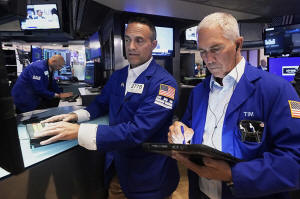Wall Street rises and snaps out of its 3-day losing streak
[September 27, 2025] By
STAN CHOE
NEW YORK (AP) ó U.S. stocks climbed Friday and trimmed their losses for
the week after a report showed that inflation is behaving roughly as
economists expected, even if itís still high.
The S&P 500 rose 0.6% and broke its three-day losing streak. The Dow
Jones Industrial Average gained 299 points, or 0.7%, and the Nasdaq
composite added 0.4%. All three indexes pulled closer to the all-time
highs they set at the start of the week.
Stocks got some help from a report showing that inflation in the United
States accelerated to 2.7% last month from 2.6% in July, according to
the measure of prices that the Federal Reserve likes to use. While
thatís above the Fedís 2% target, and itís more painful than any
household would like, it was precisely what economists had forecast.
That offered some hope that the Fed could continue cutting interest
rates in order to give the economy a boost. Thatís critical for Wall
Street because itís already sent U.S. stocks on a blistering run to
records from a low in April in large part because of expectations for a
string of rate cuts.
Without such cuts, growing criticism that stock prices have become too
expensive by rising too quickly would become even more powerful. The Fed
just delivered its first rate cut of the year last week but is not
promising more because they could worsen inflation.
One factor threatening to push inflation higher is President Donald
Trumpís tariffs, and he announced a set of more late Thursday. They
include taxes on imports of some pharmaceutical drugs, kitchen cabinets
and bathroom vanities, upholstered furniture and heavy trucks starting
on Oct. 1.
Details were sparse about the coming tariffs, as is often the case with
Trumpís pronouncements on his social media network. That left analysts
unsure of their ultimate effects, and the announcement created ripples
in the U.S. stock market instead of huge waves.
Paccar, the company based in Bellevue, Washington, thatís behind the
Peterbilt and Kenworth truck brands, revved 5.2% higher, for example.
Big U.S. pharmaceutical companies nudged higher. Eli Lilly rose 1.4%,
and Pfizer added 0.7%.

Several companies that sell home furnishings, which could be hurt by
higher prices for imports, swung between gains and losses.
Williams-Sonoma went from an initial loss of 2.5% to a modest gain and
back to a loss before rising 0.1%. RH dropped 4.2% following its own
back and forth.
On the losing end of Wall Street was Costco Wholesale, which fell 2.9%
even though it reported a stronger profit for the latest quarter than
analysts expected. Renewal rates for its membership slowed a touch,
while an important measure of underlying revenue growth at its stores
fell short of analystsí expectations.
[to top of second column] |

Specialist Michael Gagliano, left, and trader Timothy Nick work on
the floor of the New York Stock Exchange, Wednesday, Sept. 17, 2025.
(AP Photo/Richard Drew)
 All told, the S&P 500 rose 38.98
points to 6,643.70. The Dow Jones Industrial Average added 299.97 to
46,247.29, and the Nasdaq composite gained 99.37 to 22,484.07.
In stock markets abroad, indexes rose in Europe after slumping in
Asia.
Franceís CAC 40 climbed 1%, while South Koreaís Kospi tumbled 2.5%
for two of the worldís bigger moves.
Japanís Nikkei 225 fell 0.9% as Sumitomo Pharma Co.ís shares lost
3.5% and Chugai Pharmaceutical sank 4.8%.
In the bond market, the yield on the 10-year Treasury held steady at
4.18%, where it was late Thursday.

A report said sentiment among U.S. consumers was weaker than
economists expected. The survey from the University of Michigan said
consumers are frustrated with high prices, but their expectations
for inflation over the coming 12 months also ticked down to 4.7%
from 4.8%.
One notable exception was among Americans who own plenty of stocks,
who have benefited from Wall Streetís run to records even as the job
market slows. Sentiment for them held steady in September, while
falling for households with smaller or no stock investments.
The next big event for Wall Street could be a looming shutdown of
the U.S. government, with a deadline set for next week. But
investors have experience with such political impasses, and they
have had limited impact on the market before.
ďThe market and broader macroeconomic effects of a shutdown, even
lengthy ones, are often mere blips on the charts,Ē according to
Brian Jacobsen, chief economist at Annex Wealth Management.
___
AP Writers Teresa Cerojano and Matt Ott contributed.
All contents © copyright 2025 Associated Press. All rights reserved |